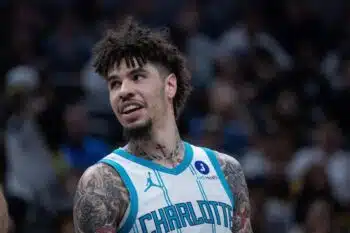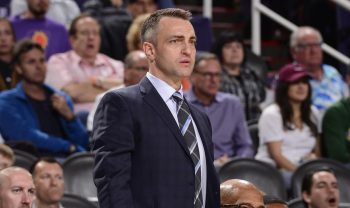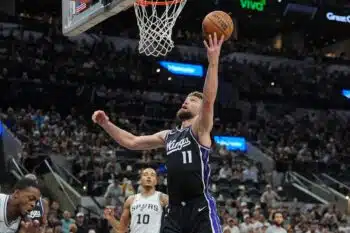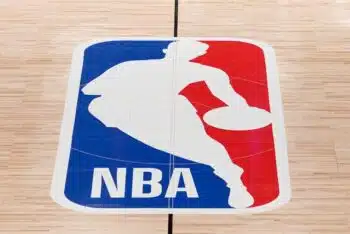NBA
How The Timberwolves’ Offense is Slowly Growing Against The Warriors
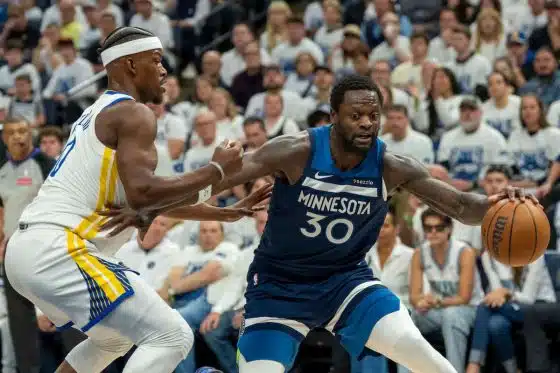
There’s nothing sportswriters love more than when a game is encapsulated by a single sequence, introductory paragraphs appearing on a silver platter. Enter the 33rd minute of the Minnesota Timberwolves’ aggravating, 99-88 Game 1 loss to the Golden State Warriors Tuesday night.
Anthony Edwards had just cut Minnesota’s deficit to 13, roasting a Kevon Looney switch set up by smooth ball movement and an offensive rebound. Following a 31-point first half, the Timberwolves were up to 22 points in the third quarter with four minutes still to go — an avalanche, by the night’s standards. With Stephen Curry nursing a strained hamstring in the locker room and the home team finally making shots, Target Center started to shake.
Alas, the backboard answered a ridiculous Jimmy Butler prayer…
How?! Jimmy.
📺 @NBAonTNT pic.twitter.com/dHMqJCZFQR
— Golden State Warriors (@warriors) May 7, 2025
…and Buddy Hield splashed home a semi-open three on the next possession.
The Warriors shot 42.9 percent from deep in Game 1 while the Wolves converted a pitiful 17.2 percent of their threes. Was that margin alone insurmountable? Probably. But in this critical juncture, the Wolves turned it over on a mad transition push, then missed two golden opportunities to hit cutters darting to the rim for should-be layups:
The Timberwolves’ Game 1 Struggles Went Beyond Shooting
A 13-point deficit ballooned to 19, then stayed there until the fourth quarter, where Minnesota’s intermittent comeback attempts fell short and felt shorter. Postgame, head coach Chris Finch did not treat all the Wolves’ missed jumpers like the reason for a loss, but rather as side effect of their struggles.
“Our transition decision-making was diabolical,” Finch told the media. “Obviously, we couldn’t hit a shot, but I didn’t like the fact that we couldn’t repeatedly generate good shots. We should’ve been able to.”
Diabolical is the perfect word to describe Minnesota’s transition offense in Game 1, so bad it must have been malevolent. It registered more turnovers than field goals on the break; thus, Cleaning the Glass calculated the Wolves lost 4.2 points per 100 possessions thanks to transition play on Tuesday, a fourth percentile mark. (The average team gains about two points of offensive rating on the break.)
In Game 1, Minnesota was killed by its inability to make a 3-pointer. Any analysis must start there, though the superb 48 percent it shot from the midrange, per CTG, suggests it didn’t get the worst shooting outcome possible. We must also account for all the points the Wolves left on the table in transition. It was an issue, like the 3-point shooting, fixed during their Game 2 victory, when they added 8.0 points of offensive rating on the break.
But Golden State didn’t just pray for missed shots and sloppy open-court play from the Wolves in the series opener. Head coach Steve Kerr’s defense banked on Minnesota being unable to create layups with sound interior passing. Edwards, Julius Randle and others missed tight reads while Rudy Gobert’s flaws as a play-finisher emerged once more. In doing so, the Warriors exposed Minnesota’s biggest obstacle to conquering a suddenly wide-open NBA Playoffs. And though Anthony Edwards & Co. made progress in this department during Game 2, they still have a long way to go, starting with Saturday night’s Game 3.
Take a look at the Warriors’ backside help on these two possessions early in Game 1 (sound on):
Golden State was comfortable putting its weak-side defenders in vulnerable positions. Sure, they have to sink to the rim and recover to the 3-point line with Draymond Green (or occasionally Looney and Butler) in such early help, but do they really have to sink to the rim? Kerr doesn’t believe that pass is getting made. If it is, he doesn’t believe in the catch-and-finish ability of Gobert, who in fact shot just 3-of-6 at the rim and fumbled two more passes out of bounds in Game 1.
This allowed Golden State’s weak-side defenders to subdue the threat of Minnesota’s skip passing. And when they weren’t forcing missed threes, they were running shooters off of the line. There’s no need for X-Outs or complicated rotations here, which let the Warriors to stay in their shell and keep Green close to the rim while preventing the threat of future drive-and-kicks. In both of those clips above, the ball changed sides just once.
Whether Gobert was on the court, the Wolves encountered the same issues. In addition, some notable spacing imperfections and a distinct lack of off-ball movement allowed Golden State to thrive in man or zone defense (sound on):
Of course, the Warriors’ defense deserves a ton of credit for its Game 1 performance. Green stonewalled drivers at the rim repeatedly, and this scheme would not have worked if his timing on rotations wasn’t pristine. It’s easy to micro-analyze every single possession on which the Wolves did not get a good shot. These small details added up, though. Every tight-window pass or potential cut that could have been made, but wasn’t, added up to an infuriating offensive performance for Finch’s group. The shooting was the sour cherry on top.
How The Timberwolves Adapted In Game 2
So, how much actually changed in Game 2? Did the Wolves’ process truly improve or did it just feel like that because they shot 43.2 percent from deep and played less like the Washington Generals in transition? The boring but true answer is both.
One undeniable upgrade was Minnesota’s movement, which came at the start and end of possessions. Finch was able to spice up the offense with some early off-ball screens to get stuff shaking rather than calling standard pick-and-rolls or dribble handoffs to initiate every time. It’s a minor detail, but one which gave ball-handlers more breathing room to operate. Here, Naz Reid comes off a pindown before driving the ball and skipping it to Edwards:
one of MIN’s best Game 2 possessions, with the ball getting from side to side to side: pic.twitter.com/LDCuMeonRD
— Lucas Kaplan (@LucasKaplan_) May 10, 2025
The real improvement comes after Edwards’ catch. He keeps the ball moving and Nickeil Alexander-Walker can then make a secondary venture into the paint. Alexander-Walker captures the attention of four Warriors before making another kickout pass to Reid, who’s relocated to the corner. The ball is now on its “third” side of the court and Golden State’s shell is broken. Open three.
So, part of it is better decision-making on the back-end. Remember, Jaden McDaniels took those two contested midrange jumpers in Game 1 a few clips ago after only one pass on the play. Some of it is stronger decision-making on the front end; Wolves fans should feel comfortable about that, given the recent play of Edwards. He was a strong initiator in Game 2, which isn’t an aberration but the new norm for him.
Below, instead of charging into help and hanging in the air to make a skip pass, he holds Pat Spencer on his back and drives all the way under the basket. That pulls Butler, the weak-side helper, all the way in and makes the kickout pass for three a routine play. Boom.
Ant’s drives were much better and calmer in Game 2, here holding the defender on his back and forcing Jimmy Butler to sink further into the paint: pic.twitter.com/xvPHVF7KFM
— Lucas Kaplan (@LucasKaplan_) May 10, 2025
That play came with Gobert on the court, and to say nothing of his excellent defense, he is definitely not part of Minnesota’s best five offensively. The Wolves posted a ridiculous 140 offensive rating without him in Game 2 and their drivers benefitted from a wide open paint. Plus, Reid is pretty freaking good.
I loved this play, where a simple cut by Alexander-Walker discombobulates Golden State’s help and Edwards takes full advantage of it. Without Gobert in the paint, the Warriors’ margin for rotational errors is so much thinner:
just a little bit of motion with 5-out offense did wonders for MIN in G2. NAW’s cut drags Jimmy out of the paint, confusing GSW’s help defense, and Ant is decisive: pic.twitter.com/YMdfRYxhoR
— Lucas Kaplan (@LucasKaplan_) May 10, 2025
All good, right? Not only did Minnesota make threes and effectively push pace in Game 2, but Edwards’ drives were stronger. Finch also saw his offense move smoothly without the ball and the zone Golden State employed was but a minor road bump. The Wolves were committed to continuous drive-and-kick opportunities and the Warriors’ shell was suddenly penetrable.
And yet, I’m left wanting more. Even in Game 2, they frequently missed interior opportunities (in the half-court), even during their hot start:
Gobert may be the main culprit in those clips, but he’s been just part of the problem over the series’ first 96 minutes. Remember, he wasn’t on the floor for that critical, sloppy minute of Game 1, when an open Reid roll proved fruitless before Edwards and Randle missed an easy connection.
The Keys For Minnesota’s Offense Moving Forward
Perhaps, it was simply because his team trailed by 20 in the third quarter and he was desperate to force some turnovers, but late in Game 2, Kerr showed a more aggressive hand. His defenders trapped the likes of Edwards and Donte DiVincenzo up the floor, betting Minnesota couldn’t take advantage of 4-on-3 opportunities. While the Warriors forced a couple turnovers, it was largely too late to truly judge. Thus, it’ll be interesting to see if Kerr returns to that coverage in Game 3 Saturday night.
The Timberwolves can win this series without playing perfect ball. Curry remains out until at least Game 5 while Butler seems unable or unwilling to explode off his injured glute. A reasonable 3-point percentage and transition efficiency will be enough to get the job done.
They will never dice defenses up with fantastic interior passing or finishing, but as it pertains to their ultimate ceiling in 2025, they need to be better than they have against the Warriors.
In the meantime, we’ll see if they can string together possessions of side-to-side movement and slowly break the shell of a Golden State defense that, if nothing else, is a fantastic challenge for them before the Western Conference Finals. How much can they compensate for a lack of dominant interior finishing and high-level passing?
That is what we should be watching for in Game 3 and beyond.
